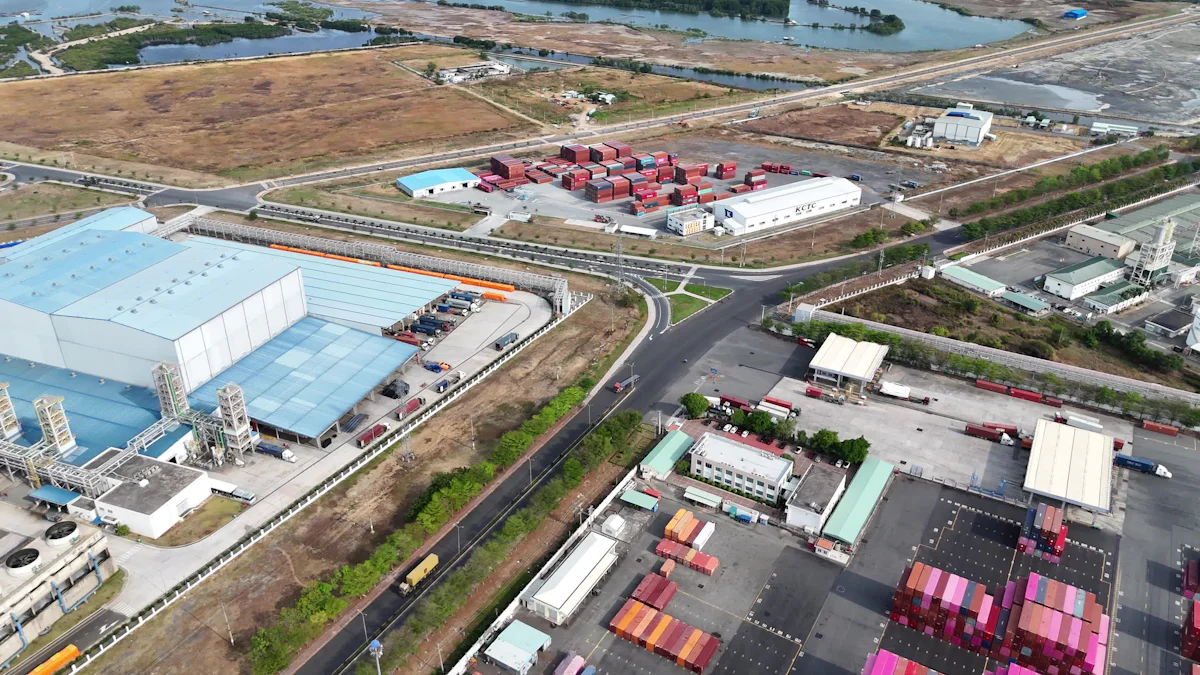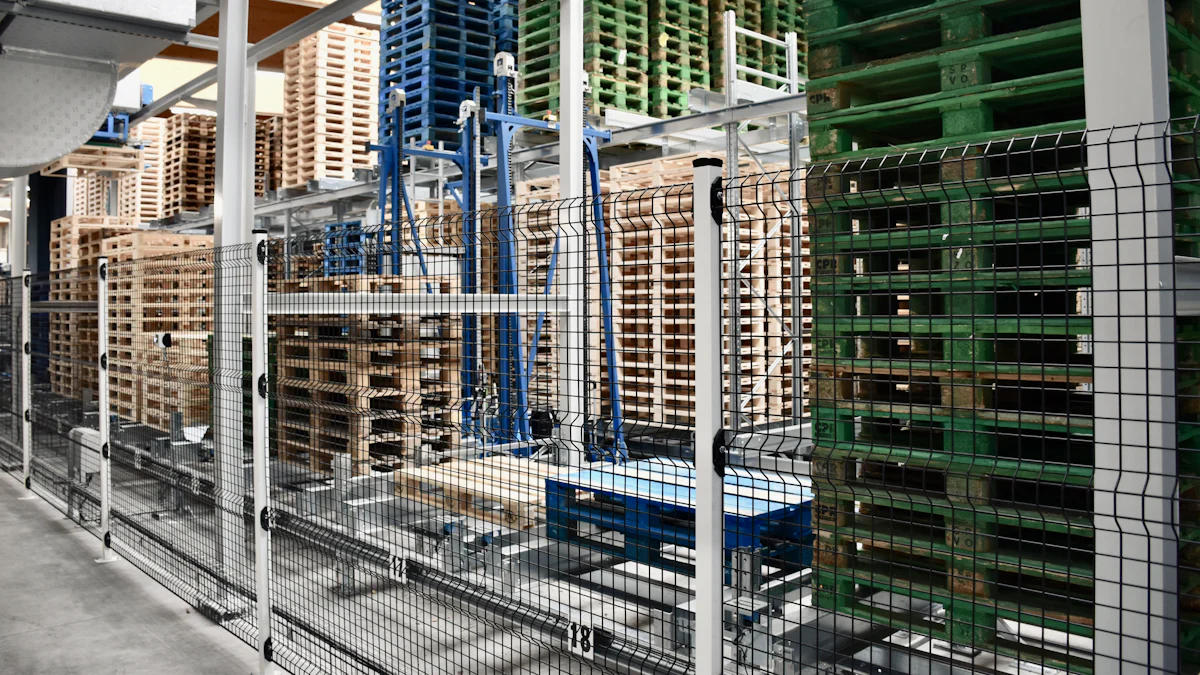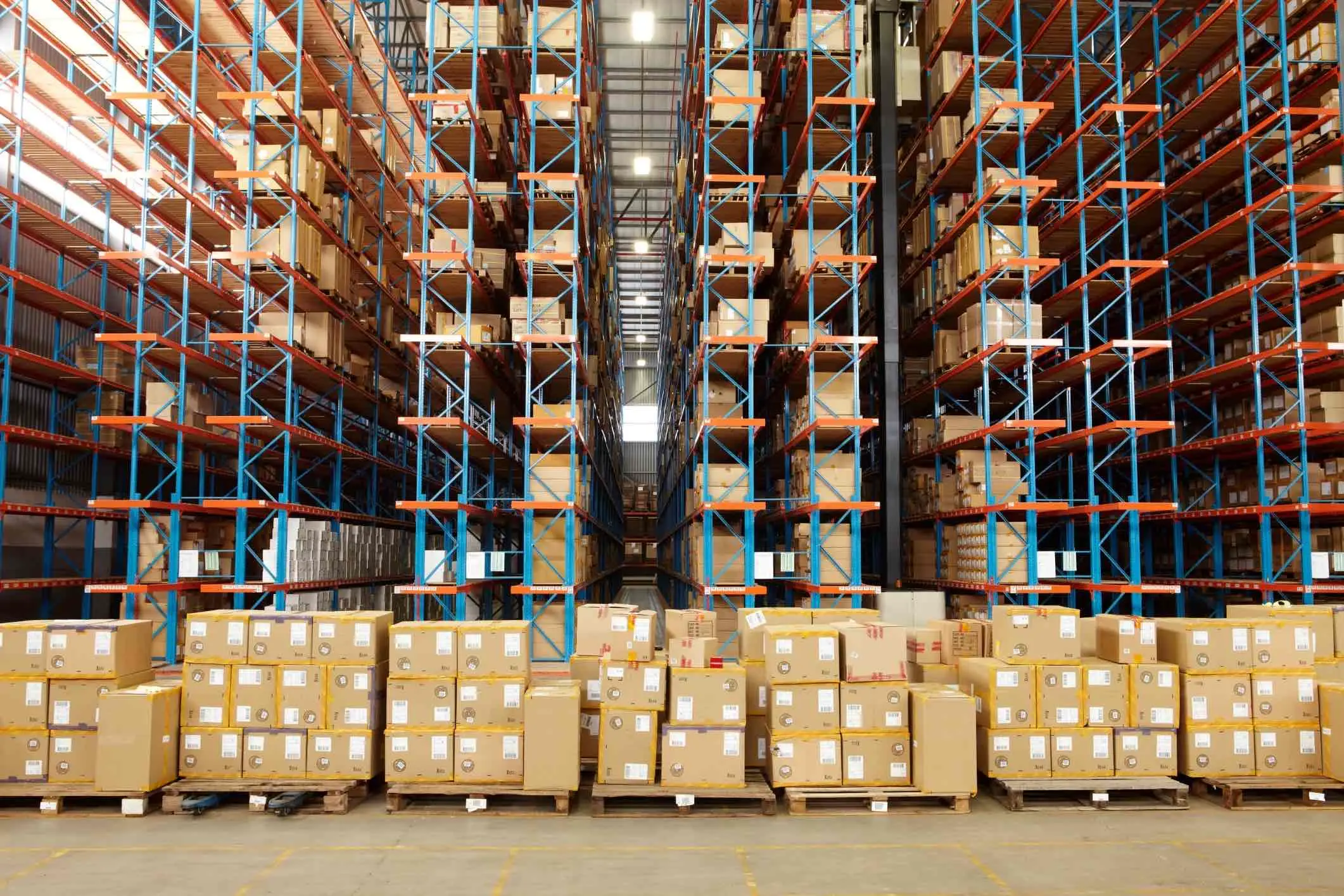How to Enhance Supply Chain Efficiency with Technology

Technology plays a vital role in transforming supply chain operations. Businesses are prioritizing digital supply chain investment to meet evolving consumer expectations, such as same-day delivery. Flexible distribution models and outsourced logistics partnerships are reshaping traditional supply chains. Investing in people ensures employee engagement and empowerment, fostering collaboration and communication for sustainable growth. Effective planning aligns systems and employees for success.
Key Takeaways
Using technology makes supply chains better by automating tasks, fixing mistakes, and making work more accurate.
Tools for tracking and seeing updates instantly, using IoT and AI, help businesses manage stock and keep customers happy.
Training workers and giving them digital tools boosts teamwork and new ideas, helping supply chains grow steadily.
Overcoming Challenges in the Supply Chain
Addressing lack of visibility and transparency
Visibility and transparency are critical for a resilient supply chain. Without them, you may face challenges such as poor inventory management, rising logistics costs, and long production cycles. These issues can disrupt operations and increase risks. For example:
Inaccurate demand predictions can lead to lost opportunities and reduced profitability.
Delayed ETAs waste valuable time and inflate costs.
Missing origin documents can cause shipment delays or rejections at ports, creating a ripple effect across your supply chain.
By adopting supply chain technology, you can overcome these obstacles. Real-time tracking tools, powered by IoT and blockchain, provide end-to-end transparency. This allows you to predict risks, optimize inventory, and improve customer satisfaction. Enhanced visibility fosters better communication and collaboration among employees, suppliers, and customers, ensuring smoother operations.
Reducing inefficiencies in manual processes
Manual processes slow down your supply chain and increase the likelihood of errors. Common time-consuming tasks include:
Manual Process | Description |
|---|---|
Inventory Management | Manual tracking leads to overstocking or stockouts. |
Production Scheduling | Adjusting schedules manually creates bottlenecks. |
Procurement | Manual purchase orders cause delays and errors. |
Quality Control | Inconsistent standards result from manual inspections. |
Financial Management | Manual bookkeeping increases inefficiencies. |
Customer Service Management | Missed opportunities arise from manual sales tracking. |
Automating these processes enhances efficiency and accuracy. For instance, automation reduces repetitive tasks, enabling employees to focus on strategic planning. It also minimizes human error, leading to better inventory tracking and order processing. This not only improves profits but also boosts employee engagement and well-being by reducing mundane workloads.
Managing high costs and delays effectively
High costs and delays can cripple your supply chain. Rising logistics expenses and operational inefficiencies often stem from outdated systems. Automation and digital tools can help you address these challenges. For example, automation provides real-time inventory visibility, reducing excess stock and warehouse costs. It also enables proactive decision-making, helping you mitigate risks before they escalate.
By investing in people through training and development, you empower your workforce to adapt to digital tools. This creates a culture of continuous improvement and collaboration. Employees equipped with the right skills can identify cost-saving opportunities and streamline operations, ensuring your supply chain remains competitive.
Key Technologies Driving Digital Supply Chain Investment

Artificial Intelligence (AI) for predictive analytics and optimization
AI transforms supply chain operations by enabling predictive analytics and optimization. It analyzes diverse data inputs, such as market trends and seasonal patterns, to improve demand forecasting. Real-time inventory tracking and predictive modeling ensure optimal stock levels, preventing overstocking or understocking. AI also enhances logistics by analyzing traffic and weather data to optimize delivery routes, reducing delays and fuel consumption. Additionally, it detects anomalies in shipment records and purchasing patterns, improving operational accuracy. These advancements allow you to make data-driven decisions, enhance efficiency, and respond dynamically to market changes.
Internet of Things (IoT) for real-time tracking and monitoring
IoT revolutionizes supply chain visibility by providing real-time data on product locations and conditions. Sensors monitor environmental factors like temperature and humidity, ensuring compliance for sensitive goods. IoT also enables predictive maintenance by identifying potential equipment failures before they occur. Real-time alerts notify stakeholders of shipment delays or tampering, improving security and transparency. By automating routine processes, IoT streamlines logistics operations and enhances collaboration among supply chain participants.
Blockchain for secure and transparent transactions
Blockchain ensures secure and transparent supply chain transactions. Its tamperproof records enhance traceability, allowing you to track goods as they move through the supply chain. A single, transparent ledger improves accountability among stakeholders, reducing disputes and delays. Blockchain also automates payments and reduces paperwork, increasing operational efficiency. Industries like logistics and shipping have successfully implemented blockchain to achieve end-to-end visibility and improve oversight.
Automation and robotics for operational efficiency
Automation and robotics significantly boost supply chain efficiency. Automated systems like drones and robotics reduce manual tasks, improving safety and productivity. Technologies such as Automated Guided Vehicles (AGVs) and Autonomous Mobile Robots (AMRs) optimize warehouse operations by minimizing wasted space and increasing throughput. Wearable devices like smart glasses assist employees in real-time inventory tracking, enhancing accuracy. These innovations reduce operational bottlenecks and improve on-time performance.
JUSDA ESG: Empowering supply chain transformation with advanced solutions
JUSDA ESG empowers supply chain transformation through its advanced solutions. It integrates manufacturing and distribution processes, offering end-to-end visibility and real-time collaboration. By leveraging IoT and big data analytics, JUSDA ESG optimizes inventory management and reduces operational costs. Its global network of service points and warehouses ensures seamless logistics across regions. JUSDA ESG aligns with ESG principles, promoting sustainability while enhancing supply chain resilience. This makes it an indispensable partner for businesses aiming to achieve digital transformation and global competitiveness.
Benefits of Investing in Supply Chain Technologies
Cost reduction and process optimization
Investing in supply chain technology allows you to streamline operations and reduce costs. Automation eliminates manual errors, saving time and resources. For example, technologies like AI and IoT enable accurate demand forecasting and inventory optimization, reducing excess stock and storage expenses. Outsourcing logistics or procurement tasks can further enhance efficiency. Transparent communication with suppliers ensures better collaboration, while cohesive management software integrates departments for seamless operations.
Method | Description |
|---|---|
Outsourcing | Engaging external services for procurement, logistics, or customer service to enhance efficiency. |
Technology Utilization | Leveraging mobile technology and the internet for marketing, sales, and communication. |
Inventory Optimization | Managing inventory levels across regions to reduce working capital. |
Transportation Processes | Streamlining transportation to align with strategic supply chain actions. |
These methods, combined with digital tools, optimize processes and improve supply chain resilience.
Enhanced accuracy and data-driven decision-making
Supply chain technology improves data accuracy, enabling better decision-making. Advanced systems provide real-time data access, ensuring 99.9% accuracy or higher. This level of precision supports strategic planning and eliminates reliance on outdated historical data. Smart sensors and transport management systems detect weaknesses instantly, allowing you to address issues proactively. Companies like IBM and Unilever have leveraged data analytics to transform their supply chains, achieving cost reductions and improved supplier performance.
Company | Strategy Description | Results Achieved |
|---|---|---|
IBM | Uses data analytics to optimize global supply chain. | 15% reduction in procurement costs, 20% improvement in supplier performance. |
Unilever | Leverages predictive analytics for supplier collaboration and risk reduction. | 30% reduction in supply chain risks, 25% improvement in supplier performance. |
By adopting digital solutions, you can make informed decisions that enhance operational efficiency.
Faster delivery and improved customer engagement
Technology accelerates delivery times and strengthens customer relationships. Route optimization tools and real-time tracking systems ensure timely deliveries by avoiding traffic or weather-related delays. Efficient warehousing and fulfillment processes also contribute to faster order processing. Improved customer engagement stems from better communication and transparency. Real-time updates and alerts keep customers informed, enhancing satisfaction and loyalty. Positive experiences encourage repeat business and strengthen your brand reputation.
Factor | Description |
|---|---|
Efficient route planning minimizes distance and avoids obstacles, reducing delivery time. | |
Warehousing & Fulfillment Efficiency | Efficiency in sorting and handling at the warehouse affects overall delivery times. |
Technology & Communication | Real-time tracking and customer alerts enhance coordination and reduce delays. |
Empowering employees through technology-driven tools
Digital tools empower employees by reducing repetitive tasks and enhancing their well-being. Automation handles mundane processes, allowing your workforce to focus on strategic roles. Training and development programs equip employees with the skills needed to adapt to new technologies. This fosters employee engagement and creates a culture of continuous improvement. Collaborative platforms improve communication and strengthen relationships among team members, suppliers, and customers. Empowered employees drive innovation and contribute to a resilient supply chain.
Steps to Implement Technology in Your Supply Chain

Assessing current supply chain needs and identifying pain points
Before implementing technology, you need to evaluate your supply chain needs and identify pain points. Start by setting realistic expectations. Understand your goals for technology integration and quantify the expected benefits against costs. Assess how your company currently uses technology. Evaluate your workforce’s skills, existing tools, and the interoperability of your systems. Dive into your data to consolidate and analyze it effectively. This step ensures you maximize the returns on digital tools like AI.
To identify pain points, use tools such as real-time data analytics and inventory tracking. A unified cloud-based platform can provide insightful data, while automated decision-making processes optimize operations. End-to-end collaboration enhances your ability to respond to demand changes. These strategies help you pinpoint inefficiencies and prepare for a smoother transition to digital solutions.
Aligning digital supply chain investment with business goals
Aligning your digital supply chain investment with business goals requires a clear understanding of customer needs and operational challenges. Stay agile to adapt to rapid technological changes. Encourage employee feedback to foster collaboration and uncover potential roadblocks. Continuously monitor and adjust your strategies to ensure alignment with your objectives. This approach strengthens communication across teams and ensures your investment drives measurable results.
Training and empowering employees for successful adoption
Training and development are critical for empowering employees to embrace new technologies. Equip your workforce with the skills needed to operate digital tools effectively. Provide hands-on training sessions and create a culture of continuous learning. Employee engagement improves when they feel confident using new systems. Empowered employees contribute to better collaboration, stronger relationships, and enhanced supply chain resilience. This focus on well-being ensures a smoother transition and long-term success.
Starting with pilot projects and scaling with confidence
Begin with pilot projects to test the effectiveness of new technologies. Select a specific area of your supply chain to implement the solution. Monitor the results closely and gather feedback from employees. Use these insights to refine the process before scaling. This method minimizes risks and builds confidence in your digital transformation. Gradual scaling ensures your supply chain planning aligns with your business goals and supports sustainable development.
Avoiding Common Pitfalls in Supply Chain Technology Adoption
Ensuring employee engagement and change management
Adopting new supply chain technologies requires more than just financial investment. You must focus on employee engagement to ensure a smooth transition. Employees often resist change due to fear of the unknown or lack of understanding. To overcome this, involve your workforce early in the planning process. Open communication about the benefits of digital tools fosters trust and collaboration. Training and development programs equip employees with the skills needed to adapt, boosting their confidence and well-being. Empowerment through hands-on training ensures they feel valued and ready to embrace new systems. This approach strengthens relationships within teams and enhances overall resilience.
Integrating new technologies with existing systems
Integrating digital tools into your supply chain can present challenges. System incompatibility often leads to delays and inefficiencies. Data silos hinder information sharing, reducing decision-making accuracy. To address these issues, evaluate your current systems and ensure compatibility with new technologies. Use cloud-based platforms to centralize data and improve collaboration. Real-time integration enhances communication between departments, streamlining operations. By addressing these challenges proactively, you can create a seamless digital supply chain that supports your business goals.
Prioritizing data security and compliance
Increased digitization in the supply chain raises concerns about data security. Cyber threats can disrupt operations and compromise sensitive information. To mitigate these risks, follow best practices for data protection. Conduct a supply chain risk assessment to identify vulnerabilities. Work closely with suppliers to strengthen security measures. Limit access to critical assets and monitor supplier activity regularly. Develop an incident response plan to address potential breaches swiftly. Strengthening your data management practices ensures compliance and safeguards your digital supply chain. This proactive approach builds trust among stakeholders and enhances operational resilience.

JUSDA Solutions
To provide you with professional solutions and quotations.
Technology has revolutionized the supply chain, driving efficiency and resilience. By investing in digital tools, you can streamline operations, reduce costs, and enhance employee engagement. Strategic planning ensures alignment between systems and employees, fostering collaboration and communication. Solutions like JUSDA ESG empower your business to embrace digital transformation, enabling sustainable growth and global competitiveness.
See Also
Improving Supply Chain Efficiency Through Cloud-Based Solutions
Embracing Technology: Transforming Supply Chains for Success
Streamlining Supply Chains in High-Tech Manufacturing Environments
Boosting Supply Chain Performance with AI Innovations
Discover 5 Cutting-Edge Techniques for Supply Chain Optimization
